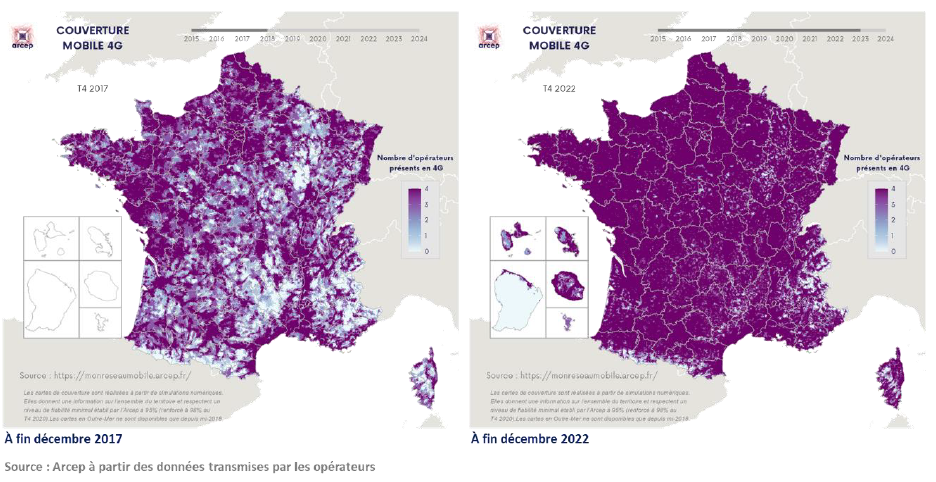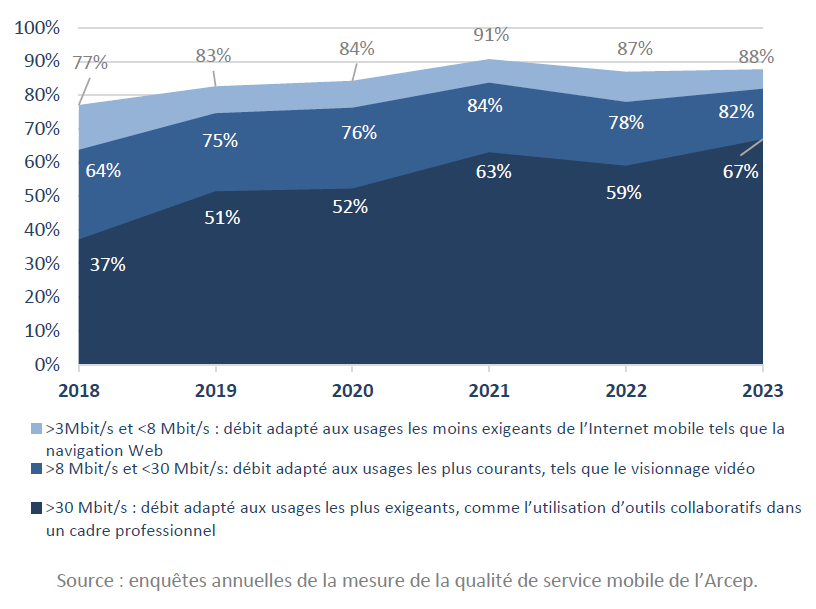In January 2018, the Government and Arcep together announced a set of commitments from operators to achieve nationwide 4G access, and accelerate mobile coverage in the regions: the New Deal for Mobile. Five years after its launch, with the deadline for meeting several obligations set for 2031, Arcep is publishing a status report on the progress made since 2018, in terms of both mobile coverage and quality of service.
Significant progress in mobile coverage in Metropolitan France
With the aim of providing “nationwide high quality mobile coverage for everyone in France,” some of the obligations to emerge from the New Deal for Mobile were designed to accelerate and improve mobile connectivity, both for superfast mobile services (4G), and voice and texting services (2G/3G).
Regarding superfast mobile services, between the end of 2017 and the end of 2022, the number of cell sites that were 4G-ready more than doubled, and mobile operators deployed 4G at between 9,600 and around 15,500 cell sites, depending on the operator. As a result, the percentage of the country with 4G coverage from all four rose from 45% at the start of 2018 to 88% in Q3 2023. During that same period, the percentage of the country located in a white (aka dead) zone shrank from 11% to 1.9%.
Progression of 4G coverage by number of operators between 2018 and 2022
In just a few years, 4G mobile coverage across France has evened out. In 2015, only six departments, all of them located in the Île-de-France (aka Paris) region, had 4G coverage over more than 90% of their surface area. By the end of 2022, only six departments in Metropolitan France had 4G coverage that was below 90% of their surface area.
In terms of voice and texting services, more than 99% of the country’s population now has access to, at minimum, “good quality coverage” (see inset below). The percentage of the population that has access to this level of coverage, which ranged from 98.6% to 99.3% the end of 2020[1], depending on the operator, rose to between 99.5% and 99.7% by the end of 2022. During that same period, the percentage of the population that enjoyed “very good coverage”, which stood at between 91.2% and 93.6% at the end of 2020 depending on the operator, stood at between 92.3% and 96.1% at the end of 2022.
Overall improvement in the quality of mobile services
The progression in mobile coverage went hand in hand with an improvement in QoS on mobile networks.
In terms of voice and texting services (2G/3G), the tests performed as part of Arcep’s annual QoS audit reveal a progression in voice quality indicators between 2019 and 2023. This improvement was observed in every type of area: rural areas, medium-density areas and high-density areas, to degrees that vary between + 8% and + 10%.
The improved quality of service on mobile networks is also reflected in mobile internet quality of service. In terms of speed, for instance (see graph below), between 2018 and 2023, the percentage of tests that revealed a downstream speed of at least 3 Mbit/s rose from 77% to 88%. During this same period, the percentage of tests that logged speeds in excess of 8 Mbit/s, revealed an even greater increase: rising from 64% to 82%.
Progress in the percentage of downstream speeds above 3.8 and 30 Mbit/s (in %)
• 3 Mbit/s and 8 Mbit/s: speed suited to the least demanding mobile internet uses such as Web browsing
• 8 Mbit/s and 30 Mbit/s: speed suited to the most common uses, such as watching videos
• 30 Mbit/s: speed suited to the most demanding uses, such as the use of collaborative tools in the workplace
Mobile coverage and quality of service improving in rural areas, but there is still room for progress
The “targeted coverage” mechanism has a special role to play within the New Deal for Mobile. It is designed to improve local coverage in areas where local authorities and the Government have identified a need for regional digital development. Operators much each ensure coverage of 5,000 such areas, within a maximum 24 months after having been appointed to cover said area, by Government Order. By and large, the deployments carried out under this mechanism are progressing at the pace set by the original timetable. As a result, as of 30 September 2023, 4,374 areas to be covered had been designated, and more than 2,600 cell sites put into service. The mechanism has also had a powerful effect on mobile infrastructure sharing in rural areas. More than 90% of the cell sites deployed under the targeted coverage mechanism are shared by all four operators.
With the New Deal for Mobile, and particularly this targeted coverage mechanism, rural areas have been among the prime beneficiaries of operator rollouts. Of the close to 35,000 mobile cell sites that launched commercially during this period, more than 23,500 (or 67% of the sites) are located in rural areas. On the other hand, if performances tested during Arcep’s annual QoS audits are improving, in 2023 they continue to fall short of those observed in more densely populated parts of the country.
Several mechanisms should help improve coverage and quality of service in the coming years, including the targeted coverage mechanism which is expected to bear fruit up to the end of 2026, as well as the obligation to provide “good coverage” for voice and texting services to 99.8% of the population, whose deadlines are staggered between 2028 and 2031 depending on the operator. The obligations set as part of the award of licences to use 3.5 GHz (core 5G) band frequencies will also further bolster this progress, with the deployment of at least 25% of the new cell sites in municipalities in sparsely populated areas, and industrial areas, along with obligations to improve speeds at existing sites and the coverage of roadways, according to an expanded scope of reference.
Regarding priority transport corridors, roadside 4G coverage ranges between 99.4% and 99.9% depending on the operator. On railway lines, 4G coverage along the tracks stands at between 97.7% and 99.3%. Although the performances on roadways measured by Arcep have improved, they nevertheless remain only average on-board trains, particularly when it comes to mobile internet access.
Residential connectivity improving thanks solutions introduced by operators
Since December 2022, operators Bouygues Telecom, Free mobile, Orange and SFR have been required to provide their “consumer” mobile customers with solutions that enable them to access voice and texting services over Wi-Fi. Since the end of 2019, the volume of voice over Wi-Fi calls has increased threefold. They represented 5.7% of total voice calls made using mobile phones in Q2 2023.
In addition, all four mobile operators now offer fixed internet access solutions over their mobile network, and publish a list of the geographical areas where these plans are available. As of 31 December 2022, more than 400,000 users were subscribing to one of these fixed 4G plans.
Arcep monitors operators’ compliance with the obligations introduced under the New Deal for Mobile
The Arcep Body responsible for settling disputes, legal proceedings and investigations (RDPI) is responsible for monitoring operators’ compliance with their obligations. As part of this process of monitoring obligations tied to the New Deal for Mobile, the RDPI Body has been required to render multiple decisions to issue operators with formal notices to comply with their obligations, including some in advance starting in 2019[2]. These decisions are being published today.
New Deal for Mobile, a paradigm shift
The New Deal for Mobile marked a paradigm shift. By making regional development a priority rather than a criterion when assigning frequencies (through an auction process), the Government elected to steer operators’ efforts towards achieving nationwide coverage, through unprecedented coverage obligations.
Some of the licences to use the 900 MHz, 1800 MHz and 2.1 GHz band frequencies awarded to mobile operators in Metropolitan France, representing close to half of the frequencies available to mobile telephony, were due to expire between 2021 and 2024. Their renewal created an opportunity to introduce ambitious coverage obligations that would help achieve regional digital coverage objectives of providing everyone in France with high quality mobile coverage.
As a result, in January 2018, the Government and Arcep together announced a set of commitments from operators to accelerate mobile coverage in the regions: this was the New Deal for Mobile. In July 2018, these commitments were then written into existing spectrum licences to make them legally binding, and in the subsequent frequency licence award decisions at the outcome of the assignment procedures.
Every quarter, Arcep releases indicators that allow elected officials and all of the stakeholders to track operators’ progress on every aspect of the New Deal for Mobile.
Associated documents
[1] Data on operators’ “good coverage” and “very good coverage” for voice and texting services (2G/3G) are only available from 2020 onwards. The obligation for operators to publish 2G/3G coverage maps was introduced following the 31 March 2020 review of Arcep Decision No. 2016-1678 of 6 December 2016.
[2] Some of these have been dismissed due to the progress made in the interim.


